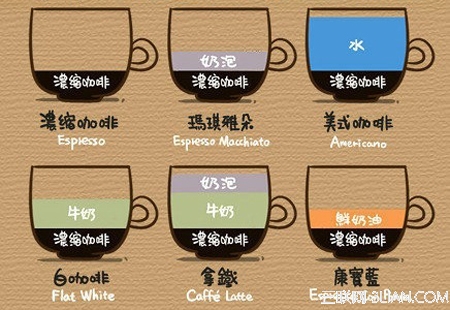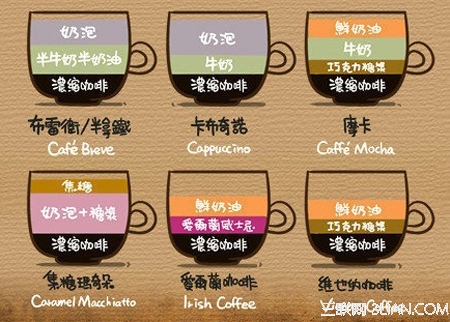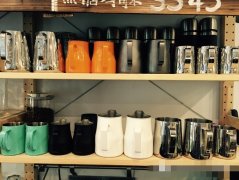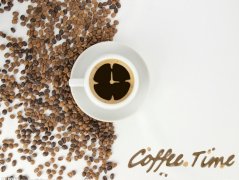Interesting introduction to the common way of calling coffee what is the common coffee?
I hear a lot about coffee, but do you know the names of all kinds of coffee easily? What are the common types of coffee, what are its practices and ingredients? A few days ago, a website organized and drawn such a lovely picture to let you know the composition of coffee at a glance. You will know after reading this article. The next time you go to a cafe, you don't have to ask people what you should drink.

Espresso (Espresso), originally in Italian, means "make it for you right away". It is commonly known as Italian espresso. Espresso is the use of high pressure, so that boiling water quickly through the coffee powder in just a few seconds, to get about 1 ounce of coffee, bitter and fragrant.
Macchiato (Espresso Macchiato). The original text of Macchiato is Italian, which stands for "imprint, imprint". It is pronounced "Macchiato", but we are used to calling it Macchiato. Macchiato is to add a thin layer of hot milk foam to the espresso to keep the coffee warm. The delicate and sweet milk foam can cushion the bitter impact of espresso. If you want to drink coffee but can't give up the sweetness, you can choose macchiato.
American coffee (Americano). Black coffee is made using instruments such as drip coffee pots, siphon pots, French presses, etc., or a large amount of water is added to Italian espresso. The taste is light, but because of the long extraction time, the caffeine content is high.
White coffee (Flat White). Malaysian native products have a history of more than 100 years. White coffee does not mean that the color of coffee is white, but uses special coffee beans and special skimmed cream raw materials, after special processing of coffee, glycol aroma does not hurt the intestines and stomach, retaining the original color and flavor of coffee, the color is lighter and softer than ordinary coffee, so it is named white coffee.
Latte (caf è Latte). The latte is as simple as pouring nearly boiling milk into a freshly made espresso. In fact, there is no fixed rule on how much milk is added, and it can be freely mixed according to individual taste.
Campbell Blue (Espresso Con Panna). In Italian, Con means stirring, Panna is whipped cream, and Campbell blue means espresso with whipped cream. There is a saying that the authentic Campbell Blue should be served with a chocolate or toffee, first put the chocolate or toffee in your mouth, and then drink coffee to let the delicacy bloom in your mouth.

Brewer / half latte (Cafe Breve). Much like a latte, the difference is that it is not milk, but a mixture of half-milk and half-cream, sometimes with a little foam.
Cappuccino (Cappuccino). The traditional cappuccino is 1/3 espresso, 1/3 steamed milk and 1/3 foamed milk. Cappuccinos are divided into dry and wet ones. Dry cappuccino (Dry Cappuccino) refers to the conditioning method with more milk bubbles and less milk, and the coffee tastes stronger than milk flavor. Wet cappuccino (Wet Cappuccino) refers to the practice of fewer milk bubbles and more milk, with the smell of milk overshadowed by the thick smell of coffee, which is suitable for those with light taste.
Caff è Mocha. One of the oldest coffee, named after the famous port of Mocha. Mocha is a mixture of Italian espresso, chocolate syrup, whipped cream and milk. It is a variant of Italian latte.
Caramel macchiato (Caramel Macchiato). Macchiato with caramel is a drink made by adding espresso and vanilla to strong hot milk and finally sprinkled with pure caramel. it is characterized by three different flavors in one drink.
Irish coffee (Irish Coffee). A kind of coffee that looks like both wine and coffee is made by mixing hot coffee, Irish Whiskey, cream and sugar.
Viennese coffee (Viennese Coffee). Austria's most famous coffee, sprinkle a thin layer of sugar or rock sugar on the bottom of a warm coffee cup, then pour hot and thick black coffee into the cup, and finally decorate the coffee surface with two tablespoons of cold fresh cream. A cup of Viennese coffee is ready.
Important Notice :
前街咖啡 FrontStreet Coffee has moved to new addredd:
FrontStreet Coffee Address: 315,Donghua East Road,GuangZhou
Tel:020 38364473
- Prev

How to choose a comprehensive standard of a good milk tank
With regard to milk jars and powder hammers, they should be two necessary equipment for many baristas, which are related to the design of powder hammers. Different shapes of powder hammers are generally related to the comfort of the hand, and whether the bottom surfaces are smooth or uniform. Whether it can better reduce the channel effect. The rest is workmanship, brand, material processing. And many baristas, especially some hobbies of flower drawing.
- Next

Teach you how to allocate time for coffee and the best time for coffee.
It's nice to enjoy the beauty of coffee, but can you drink the right coffee at the right time? Enjoying different coffee at different times and in different moods can have different effects of refreshing, relaxing, soothing or stimulating. Follow the daily life trajectory and mood changes of office workers, and let the coffee schedule tell you how to choose coffee. 07:00 on the way to work
Related
- Detailed explanation of Jadeite planting Land in Panamanian Jadeite Manor introduction to the grading system of Jadeite competitive bidding, Red bid, Green bid and Rose Summer
- Story of Coffee planting in Brenka region of Costa Rica Stonehenge Manor anaerobic heavy honey treatment of flavor mouth
- What's on the barrel of Blue Mountain Coffee beans?
- Can American coffee also pull flowers? How to use hot American style to pull out a good-looking pattern?
- Can you make a cold extract with coffee beans? What is the right proportion for cold-extracted coffee formula?
- Indonesian PWN Gold Mandrine Coffee Origin Features Flavor How to Chong? Mandolin coffee is American.
- A brief introduction to the flavor characteristics of Brazilian yellow bourbon coffee beans
- What is the effect of different water quality on the flavor of cold-extracted coffee? What kind of water is best for brewing coffee?
- Why do you think of Rose Summer whenever you mention Panamanian coffee?
- Introduction to the characteristics of authentic blue mountain coffee bean producing areas? What is the CIB Coffee Authority in Jamaica?

